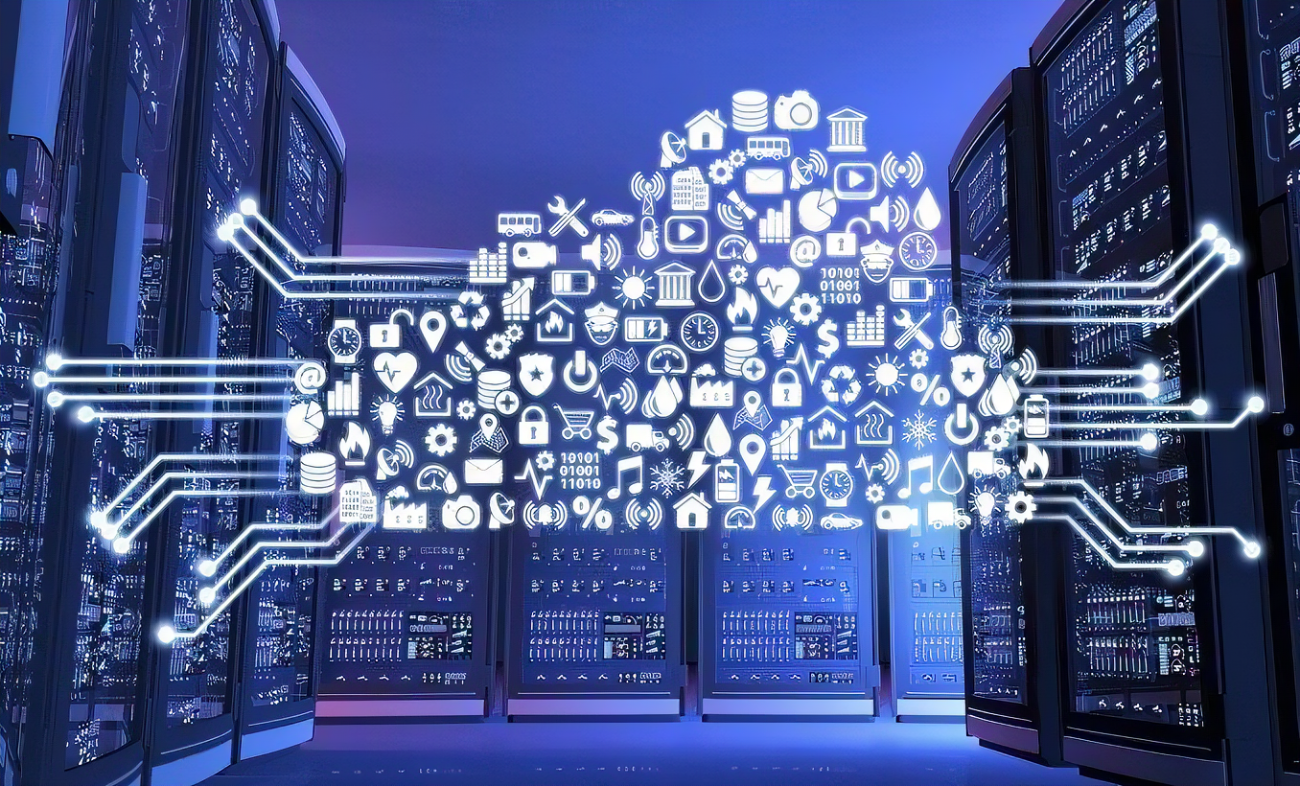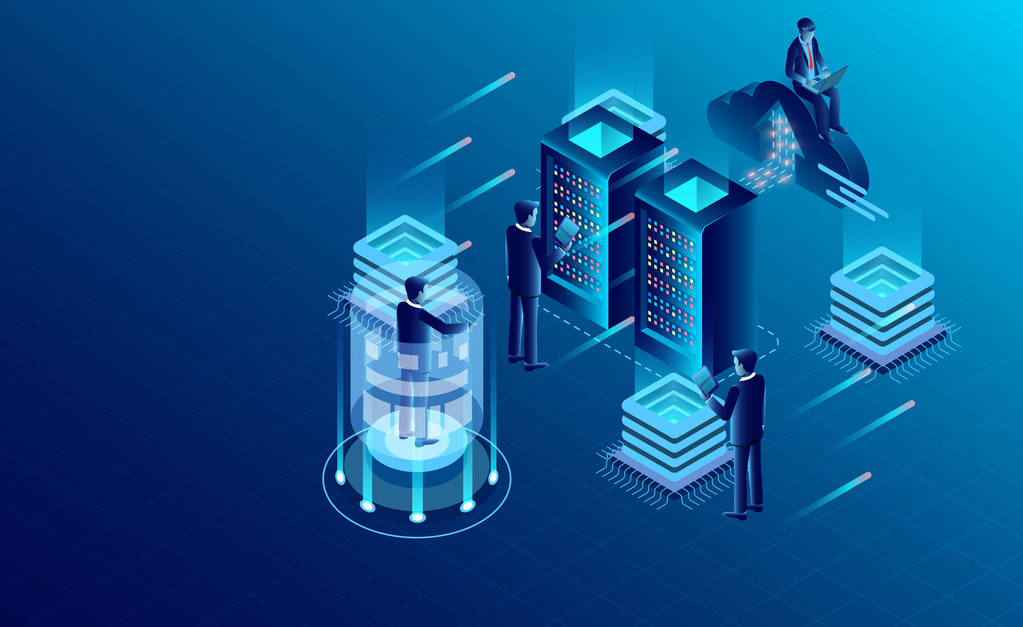Introduction:
With the rapid development of artificial intelligence (AI) technology and the increasing demand for computing resources, big data centers have become a key infrastructure supporting AI computing power. They not only provide large-scale data storage capabilities, but also concentrate high-performance computing resources, providing a platform for enterprises to implement complex algorithms and model training. This article aims to explore the core role of big data centers in AI computing power and analyze how various enterprises can strategically layout in this field.

1、 The definition and functions of big data centers
A big data center refers to a facility equipped with a large number of servers and network devices for centralized management and processing of massive data. Its main functions include data storage, data processing, data analysis, and cloud computing services. In terms of AI computing power, big data centers support the operation of machine learning and deep learning algorithms by providing powerful computing power and efficient network connections.
2、 The role of big data centers in AI computing power
1. Providers of computing power
The big data center provides necessary computing resources for AI algorithms by integrating high-performance processors and server clusters. This centralized computing architecture enables complex AI models to complete training and inference in a short amount of time, greatly improving the efficiency and speed of AI applications.
2. The hub of data processing
The effectiveness of AI algorithms largely depends on the quality and quantity of data. Big data centers can store and process massive amounts of data from different sources, providing rich and accurate information input for AI models, thereby improving the performance and accuracy of the models.
3. An innovative incubator
Big data centers are not only places for computing and data processing, but also incubators for new technologies and applications. Enterprises can utilize the resources of big data centers to develop and test new algorithms, accelerating the innovation and commercialization process of AI technology.
3、 The layout strategy of enterprises in the field of big data centers
1. Self built data center
Large technology enterprises and Internet giants usually choose to build or expand big data centers to meet their growing network security needs and data processing capabilities. For example, companies such as Google, Amazon, and Microsoft have established multiple large data centers worldwide to support the development of their cloud services and AI products.
2. Collaborative construction model
Small and medium-sized enterprises or startups often lack sufficient funds and technological capabilities to build their own data centers. Therefore, they tend to collaborate with third-party data center service providers to share resources and technology. This model reduces the initial investment and operating costs of enterprises, while also enabling quick access to high-end computing resources.
3. The role of cloud service providers
Cloud service providers play an important role in the field of big data centers. They enable enterprises to enjoy efficient data processing capabilities without the need to build their own data centers by providing on-demand allocation of computing resources and services. Domestic cloud service providers such as Alibaba Cloud and Tencent Cloud are actively expanding their data center networks to meet the growing industry demand for AI computing power in the market.
Conclusion:
As an important carrier of AI computing power, the strategic position of big data centers cannot be ignored. Various enterprises are adopting different layout strategies based on their own resources and needs to fully utilize the advantages of big data centers. Whether through self construction, collaboration, or leveraging cloud services, the goal of enterprises is to acquire stronger AI computing power to drive technological innovation and business development. With the continuous progress of AI technology and the expansion of application scenarios, the position and role of big data centers will become increasingly prominent, and competition and cooperation among enterprises in this field will also become more intense.
Introduction:
In the current information age, communication big data service centers have become a key pillar of modern society's operation. These centers are not only responsible for collecting, processing, and storing massive amounts of data, but also play an important role in promoting innovation and development in various industries. This article will explore the functions, technical challenges, and contributions of communication big data service centers to social development.

1、 The functions and architecture of the communication big data service center
The main function of the Communication Big Data Service Center is to efficiently manage, quickly process, and intelligently analyze massive amounts of data from different channels. These data include multiple dimensions such as mobile communication network traffic, user behavior, and device status, providing operators with the ability to gain in-depth insights into market dynamics and service quality. To achieve this goal, communication big data service centers typically adopt distributed storage systems and parallel processing frameworks such as Hadoop and Spark to ensure real-time and accurate data processing.
2、 Technical challenges and development trends
With the popularization of 5G technology and the surge of IoT devices, communication big data service centers are facing unprecedented challenges in terms of data volume and complexity. This requires the center to continuously upgrade computing resources, optimize algorithm models, and strengthen network security protection to cope with data leakage and attack risks. In addition, the integration of artificial intelligence technology has become a new trend in communication big data processing, improving the intelligence level of data analysis and further unleashing the value of data.
3、 Promotion of scientific research
The Communication Big Data Service Center provides strong data support for scientific research. In fields such as astronomy, meteorology, and bioinformatics, through in-depth analysis of communication data, scientists can discover new laws, verify theoretical hypotheses, and accelerate the output of scientific research results. For example, through mobile signaling data mining, researchers can more accurately simulate crowd flow patterns, providing a basis for public health policy formulation.
4、 A catalyst for economic innovation
In the economic field, the role of communication big data service centers is equally important. It provides enterprises with precise market analysis tools to help them grasp consumer needs, optimize product design and service processes. Meanwhile, through the integration and analysis of supply chain data, enterprises can achieve effective resource allocation, improve operational efficiency, and reduce costs. The data-driven decision-making model has become an important source of competitiveness for enterprises.
5、 Optimization of public services
The Communication Big Data Service Center helps the government improve the quality and efficiency of public services. Through real-time analysis of urban traffic flow, environmental monitoring and other data, government departments can respond promptly to emergency situations and optimize urban management. In addition, communication big data provides a foundation for the construction of smart cities, making urban operations more intelligent and humane.
6、 Social Progress: A Data Driven Future
Finally, the importance of communication big data service centers for social progress is self-evident. It not only promotes the transformation and upgrading of traditional industries such as education and healthcare, but also demonstrates enormous potential in environmental protection, disaster prevention, and other areas. With the promotion of the concept of data openness and sharing, communication big data will become a new platform for social governance and citizen participation, promoting social fairness, justice, and sustainable development.
Conclusion:
In summary, as the core infrastructure of the digital era, the communication big data service center is profoundly influencing all aspects of society with its outstanding data processing capabilities and broad application prospects. In the face of the future, we have reason to believe that the communication big data service center will continue to play an important role in promoting technological innovation, economic growth, and social progress.
Introduction:
With the advent of the big data era, computing power has become a core resource supporting various computing tasks. However, the high cost of computing power has always been a challenge faced by enterprises and research institutions. This article will explore how to effectively reduce computing power costs and achieve optimal resource allocation from two dimensions: technology and management.

1、 Technical aspect: improving the efficiency of computing power utilization
1. Algorithm optimization
The selection and optimization of algorithms directly affect the consumption of computing power. By adopting more efficient algorithms, it is possible to reduce computational power requirements while ensuring computational quality. For example, using techniques such as pruning and quantization to reduce model size and improve computational speed. In addition, customized algorithm design for specific problems is also an effective way to reduce computational costs.
2. Hardware acceleration
Using dedicated hardware accelerators such as GPUs, FPGAs, and ASICs for computing can significantly improve computing performance and reduce energy consumption. Choosing the appropriate accelerator and properly configuring and managing it is the key to improving the cost-effectiveness of computing power.
3. Distributed computing
Distributed computing allows for the decomposition of large-scale computing tasks into multiple small tasks and parallel processing on multiple computers. This mode not only improves computing speed, but also reduces the risk of single point of failure, and can further optimize resource allocation through load balancing.
4. Cloud computing and elastic expansion
Cloud computing provides a flexible way to obtain computing resources on demand. Through cloud service providers, users can dynamically adjust their computing power scale based on actual needs, avoiding cost pressures caused by long-term investments. The elastic expansion function enables computing resources to quickly respond to business changes and improve resource utilization.
2、 Management level: Refined computing power resource management
1. Demand forecasting and planning
Accurate demand forecasting can help enterprises plan their computing resources reasonably. By analyzing historical data and combining it with business development trends, develop a scientific computing power procurement plan to avoid cost waste caused by excessive procurement or insufficient reserves.
2. Resource scheduling and optimization
An effective resource scheduling mechanism can ensure the maximum utilization of computing resources. Adopting advanced resource management systems, real-time monitoring of computing power usage, and intelligent allocation of resources based on priority and task characteristics to reduce idle and excessive usage.
3. Cost control and audit
Establish a strict cost control system, regularly audit and analyze computing power costs, identify the reasons for high costs, and develop corresponding optimization measures. Meanwhile, procurement costs can be reduced through contract negotiations, supplier diversification, and other means.
4. Employee training and cultural construction
Enhance employees' awareness of computational cost and provide training on how to use computing resources more effectively. Establish a thrifty corporate culture, encourage innovative thinking, and promote continuous improvement in technology and management.
Conclusion: Comprehensive implementation of policies to reduce computing power costs
Reducing computing power costs is a systematic project that requires a combination of technological innovation and management innovation. From algorithm optimization to hardware acceleration, from distributed computing to the application of cloud computing, and then to the refinement of resource management, each step is an important component of cost reduction. Only by comprehensively considering and implementing comprehensive policies can we achieve the minimization of computing power costs while ensuring computational efficiency.
Introduction:
In today's surging digital wave, big data and cloud computing, as two major technological pillars, are changing the world at an unprecedented speed and scale. They are not only products of modern information technology development, but also important forces driving social progress. This article will explore from a professional and objective perspective how big data cloud computing can shape the future.

1、 The Power of Big Data: A New Dimension of Insight and Decision Making
1. Capture and analysis of data flood
The core of big data technology lies in processing and analyzing massive and diverse datasets. With the proliferation of Internet of Things (IoT) devices and the popularity of the Internet, the generation of data shows an exponential growth trend. The big data platform enables enterprises to capture and analyze this data in real-time through efficient storage and computing, thereby revealing hidden patterns and correlations.
2. Scientific and precise decision-making
With the help of big data, the decision-making process has become more scientific and precise. Enterprises can predict market trends, optimize supply chain management, and even customize products and services through data analysis. Government departments can use big data to improve urban planning and enhance public service efficiency. The application of big data is expanding from business to every corner of society, affecting every aspect of our lives.
2、 Empowering Cloud Computing: A Double Leap in Flexibility and Efficiency
1. Revolution in resource allocation
Cloud computing provides on-demand access to computing resources and data storage services through networks, greatly improving resource utilization and flexibility. Enterprises and individuals no longer need to invest huge amounts of money to purchase and maintain hardware facilities, but can dynamically adjust the use of cloud services according to actual needs. This model reduces IT costs and accelerates the pace of innovation.
2. Business continuity and globalization
Cloud computing also provides strong business continuity guarantees. The geographical distribution and redundant design of data centers ensure that services can continue to operate even in the face of natural disasters or human failures. In addition, cloud computing breaks geographical limitations, allowing enterprises to easily expand into global markets and achieve cross regional collaborative work.
3、 Fusion and Innovation: The Future Path of Big Data Cloud Computing
1. Integration of Artificial Intelligence
The combination of big data and cloud computing provides a solid foundation for the development of artificial intelligence. AI algorithms rely on large-scale datasets for training, and cloud computing provides an elastic computing environment for the deployment of these algorithms. The two complement each other and promote breakthroughs in machine learning, deep learning and other fields, which in turn hasten the birth of innovative applications such as autonomous vehicle and intelligent customer service.
2. Accelerator for Industry Transformation
Big data cloud computing is becoming a key driving force for the transformation and upgrading of various industries. Whether it is risk control in the financial industry, disease diagnosis in the healthcare sector, or intelligent manufacturing in the manufacturing industry, these two technologies play a crucial role. Their application not only enhances the efficiency and competitiveness of the industry, but also brings new business models and service forms.
Conclusion:
The charm of big data cloud computing lies in its infinite possibilities and transformative power. In this data-driven era, we have witnessed the rapid development of technology and experienced the convenience of life and the improvement of work efficiency brought about by it. Looking ahead to the future, big data cloud computing will continue to deepen its influence, working together with cutting-edge technologies such as artificial intelligence and the Internet of Things to build a smarter, more efficient, and interconnected world.
Introduction:
With the advent of the information age, the communication industry has undergone unprecedented changes. The rise of big data technology has not only changed the way we acquire and process information, but also had a profound impact on the operational mode of the communication industry. This article aims to explore the application of big data technology in the field of communication and analyze its importance for industry development.

1、 Overview of Big Data Technology
Big data technology refers to the use of advanced processing modes to achieve the storage, management, analysis, and mining of massive data. It has the characteristics of large data volume, diverse types, fast processing speed, and low value density. In the field of communication, big data technology can help enterprises better understand market trends, optimize network operations, improve user experience, and enhance the scientificity of decision-making.
2、 The application of big data in the field of communication
1. Network optimization and maintenance
The stability and efficiency of communication networks are key to ensuring service quality. By collecting and analyzing a large amount of network operation data, operators can monitor the network status in real time, discover and solve potential fault points in a timely manner, thereby improving the reliability and performance of the network. In addition, big data analysis can help operators predict network traffic patterns, plan resource allocation reasonably, and reduce network congestion.
2. User behavior analysis
Understanding user habits and preferences is crucial for communication service providers. Big data technology can process and analyze multidimensional data such as user call records, text messages, and online behavior, revealing user consumption patterns and potential needs. This helps operators design more personalized service products, improve user satisfaction and loyalty.
3. Marketing strategy development
In the context of increasingly fierce market competition, precise marketing strategies have become the key to winning for communication enterprises. Big data analysis can help companies gain insight into market trends, identify target customer groups, and develop effective advertising and promotional activities. Through in-depth analysis of consumer behavior, enterprises can more accurately position the market and improve the conversion rate of marketing activities.
3、 The importance of big data in the field of communication
1. Improve operational efficiency
Big data technology enables communication enterprises to monitor and manage networks in real-time, respond quickly to market changes, and effectively reduce operating costs. By analyzing historical data, enterprises can predict future business needs, prepare in advance, and avoid wasting resources.
2. Enhance user experience
User experience is an important indicator for measuring the quality of communication services. Big data analysis can help enterprises better understand user needs, provide customized services, and enhance user stickiness. Meanwhile, through continuous data analysis, enterprises can continuously improve their services, meet user expectations, and thus enhance the overall user experience.
3. Promoting innovative development
In the rapidly changing communication market, innovation is the key to the survival and development of enterprises. Big data technology provides new perspectives and tools for enterprises, stimulating innovation in products and services. Through data-driven innovation, communication enterprises can maintain a leading position in competition and explore new growth points.
Conclusion:
In summary, the application of big data technology in the field of communication is not only important, but has also become an important force driving industry progress. It greatly enhances the competitiveness and market adaptability of communication enterprises by optimizing network operations, deepening user understanding, and improving marketing effectiveness. With the continuous progress of technology and the expansion of application scenarios, big data will continue to play an increasingly important role in the communication industry.
Introduction:
In today's rapidly developing era of informatization, the digital economy has become an important force driving social progress. In the grand picture of the digital economy, big data and computing power are undoubtedly the two most crucial pillars, which together constitute the core driving force of the digital economy. This article will explore from a professional and objective perspective how big data and computing power become the dual drivers of the digital economy.

1、 Big Data: The Eye of Wisdom for Insight into the Future
The concept of big data has attracted global attention since its inception. It is not only a collection of massive data, but also a valuable information asset mined through advanced analytical techniques. Under the framework of the digital economy, the value of big data is reflected in the following aspects:
1. Decision optimization
Through in-depth analysis of big data such as consumer behavior and market trends, enterprises can make more accurate business decisions. This data-driven decision-making approach is more scientifically reliable than traditional methods that rely on experience and intuition.
2. Product Innovation
Big data analysis can reveal unmet needs of users and provide inspiration for product innovation for enterprises. For example, by analyzing discussions on social media, companies can discover new consumer trends and design more popular products.
3. Improvement of operational efficiency
In the fields of production and manufacturing, logistics and distribution, the application of big data can significantly improve operational efficiency. By real-time monitoring and analysis of various data in the production process, enterprises can adjust their strategies in a timely manner and reduce resource waste.
2、 Computing power: the cornerstone supporting the digital world
If big data is the smart eye of the digital economy, then computing power is the cornerstone that supports this intelligent operation. Computational power, also known as computing power, refers to the speed and efficiency of a computer or other computing device in executing computing tasks. With the development of technologies such as artificial intelligence and cloud computing, the importance of computing power is becoming increasingly prominent.
1. Guarantee of algorithm implementation
In various fields of the digital economy, both risk control models for financial transactions and production scheduling for intelligent manufacturing require strong computing power as support. The improvement of computing power makes it possible to implement complex algorithms, greatly expanding the application scope of the digital economy.
2. Accelerator for data processing
Faced with massive amounts of data, without sufficient computing power support, data processing will become exceptionally slow and even impossible to complete. The enhancement of computing power means that the speed of data processing is improved, which is crucial for real-time data analysis and rapid response to market demand.
3. The driving force of emerging technologies
The development of emerging technologies such as blockchain and quantum computing has put forward higher requirements for computing power. The breakthroughs and applications of these technologies will further promote the development of the digital economy, and computing power is the key factor in achieving these breakthroughs.
Conclusion:
Big data and computing power complement each other and jointly promote the vigorous development of the digital economy. Without the support of big data, computing power will lose space to be utilized; Without the support of computing power, big data cannot fully realize its rightful value. In the future, with the continuous advancement of technology and the expansion of application scenarios, the combination of big data and computing power will become more closely intertwined. They will continue to serve as the core driving force of the digital economy, leading us towards a more intelligent, efficient, and convenient digital world.
Introduction:
The goal of big data technology is to quickly extract valuable information from diverse data sources, which involves a series of complex technical processes. The following is an overview of key technologies in big data processing:

1. Big data collection technology
Data collection is the starting point of big data technology, which involves collecting massive structured, semi-structured and unstructured data from RFID, sensors, social networks, mobile Internet and other channels. This process not only requires high-speed and reliable data capture technology, but also efficient data parsing and integration technology, as well as data quality assessment and improvement technology.
2. Big data preprocessing technology
The preprocessing stage mainly involves preliminary cleaning and transformation of the original data to remove useless information and erroneous data, and to transform complex and diverse data structures into forms that are convenient for subsequent analysis. This process includes two main steps: data extraction and cleaning.
3. Big data storage and management technology
Storing and managing big data requires a powerful storage system and efficient database management. This stage focuses on how to effectively store, represent, process, and transmit complex structured, semi-structured, and unstructured data. Technical challenges include developing efficient distributed file systems, energy-efficient storage solutions, data redundancy reduction technologies, and big data security and privacy protection technologies.
4. Big data analysis and mining technology
Big data analysis and mining techniques aim to discover valuable information and knowledge from massive amounts of data. This includes improving existing data mining and machine learning technologies, developing new data mining technologies, and overcoming technical challenges in areas such as data fusion, user interest analysis, and network behavior analysis.
5. Big data presentation and application technology
Ultimately, big data technology needs to present the mined information and knowledge to users in an intuitive way, and be applied in fields such as business intelligence, government decision-making, and public services. This includes developing various data visualization techniques and applying data processing techniques in specific fields.
Conclusion:
In summary, big data technology is a comprehensive technical system that covers the entire process from data collection to final application, with each link having its own unique technical challenges and solutions. With the continuous progress and innovation of technology, big data technology will continue to drive the digital transformation and intelligent upgrading of various industries.
Introduction:
As an important infrastructure of modern information technology, data centers carry massive data processing and storage tasks, and are the core supporting cutting-edge technologies such as cloud computing, big data analysis, and the Internet of Things. This article will provide an in-depth analysis of the infrastructure and operation and maintenance services of data centers, aiming to provide readers with an objective and authentic overview.

1、 Analysis of Data Center Infrastructure
The infrastructure of a data center usually includes four main parts: physical facilities, hardware equipment, network architecture, and management software.
1. Physical facilities
Physical facilities refer to the building and its internal environment where a data center is located, including computer room space, power supply system, cooling system, and security measures. The computer room space needs to meet certain load-bearing, shockproof, and fire protection standards to ensure the stable operation of equipment. The power supply system needs to ensure the support of uninterruptible power supply (UPS) and generator sets to ensure the operation of the data center can still be maintained in the event of a power outage. The cooling system is designed to control the temperature and humidity inside the computer room and prevent hardware overheating. Security measures include access control, monitoring, and fire protection systems to protect data centers from illegal intrusion and disasters.
2. Hardware equipment
Hardware devices mainly include servers, storage devices, and network switches. The server is responsible for running applications and processing data, the storage device is used for long-term data storage, and the network switch is responsible for data transmission within the data center and with the outside world. The selection and configuration of these devices directly affect the performance and scalability of the data center.
3. Network architecture
Network architecture refers to the internal network layout of the data center, including local area network (LAN), wide area network (WAN), Internet access point, etc. An efficient and stable network architecture can ensure high-speed data transmission and reliable service delivery. Meanwhile, network security is also an important consideration in network architecture design, including firewalls, intrusion detection systems, and encryption technologies.
4. Management software
Management software is used to monitor, manage, and optimize hardware resources in data centers. This includes virtualization software, automation tools, and monitoring systems, among others. Through these software, administrators can allocate resources more effectively, improve system utilization, and quickly respond to various faults and abnormal situations.
2、 Analysis of Data Center Operations and Maintenance Services
The operation and maintenance services of a data center refer to a series of operations and service activities carried out to ensure the stable operation of the data center. It includes daily maintenance, monitoring and early warning, performance optimization, backup and recovery, and emergency response.
1. Daily maintenance
Daily maintenance includes regular hardware checks, software updates, system upgrades, and cleaning and maintenance. These tasks aim to prevent potential malfunctions and extend the lifespan of the equipment.
2. Monitoring and early warning
By deploying a monitoring system, the operations team can monitor various indicators of the data center in real-time, such as CPU usage, memory usage, network traffic, and power consumption. Once an abnormality is detected, the system will issue a timely warning so that operation and maintenance personnel can take measures quickly.
3. Performance optimization
Performance optimization involves efficient utilization and adjustment of data center resources. This may include technical measures such as load balancing, resource pooling, and caching strategies to improve the overall performance and response speed of the data center.
4. Backup and recovery
Data backup is a key measure to prevent data loss. The data center needs to regularly perform data backups and ensure the secure storage of backup data. In the event of data loss or damage, it is possible to quickly recover data to its most recent state.
5. Emergency response
In the face of sudden system failures or disaster events, data centers need to have a comprehensive emergency response plan. This includes tasks such as fault diagnosis, emergency repairs, business continuity planning, and post disaster reconstruction.
Conclusion:
In summary, the infrastructure and operation and maintenance services of data centers complement each other, jointly ensuring the efficient and stable operation of data centers. With the continuous advancement of technology and the growing demand for business, the construction and maintenance of data centers are also constantly moving towards more intelligent and automated directions to cope with more complex and ever-changing challenges in the future.
Introduction:
With the rapid development of artificial intelligence (AI) technology and the increasing demand for computing resources, big data centers have become a key infrastructure supporting AI computing power. They not only provide large-scale data storage capabilities, but also concentrate high-performance computing resources, providing a platform for enterprises to implement complex algorithms and model training. This article aims to explore the core role of big data centers in AI computing power and analyze how various enterprises can strategically layout in this field.

1、 The definition and functions of big data centers
A big data center refers to a facility equipped with a large number of servers and network devices for centralized management and processing of massive data. Its main functions include data storage, data processing, data analysis, and cloud computing services. In terms of AI computing power, big data centers support the operation of machine learning and deep learning algorithms by providing powerful computing power and efficient network connections.
2、 The role of big data centers in AI computing power
1. Providers of computing power
The big data center provides necessary computing resources for AI algorithms by integrating high-performance processors and server clusters. This centralized computing architecture enables complex AI models to complete training and inference in a short amount of time, greatly improving the efficiency and speed of AI applications.
2. The hub of data processing
The effectiveness of AI algorithms largely depends on the quality and quantity of data. Big data centers can store and process massive amounts of data from different sources, providing rich and accurate information input for AI models, thereby improving the performance and accuracy of the models.
3. An innovative incubator
Big data centers are not only places for computing and data processing, but also incubators for new technologies and applications. Enterprises can utilize the resources of big data centers to develop and test new algorithms, accelerating the innovation and commercialization process of AI technology.
3、 The layout strategy of enterprises in the field of big data centers
1. Self built data center
Large technology enterprises and Internet giants usually choose to build or expand big data centers to meet their growing network security needs and data processing capabilities. For example, companies such as Google, Amazon, and Microsoft have established multiple large data centers worldwide to support the development of their cloud services and AI products.
2. Collaborative construction model
Small and medium-sized enterprises or startups often lack sufficient funds and technological capabilities to build their own data centers. Therefore, they tend to collaborate with third-party data center service providers to share resources and technology. This model reduces the initial investment and operating costs of enterprises, while also enabling quick access to high-end computing resources.
3. The role of cloud service providers
Cloud service providers play an important role in the field of big data centers. They enable enterprises to enjoy efficient data processing capabilities without the need to build their own data centers by providing on-demand allocation of computing resources and services. Domestic cloud service providers such as Alibaba Cloud and Tencent Cloud are actively expanding their data center networks to meet the growing industry demand for AI computing power in the market.
Conclusion:
As an important carrier of AI computing power, the strategic position of big data centers cannot be ignored. Various enterprises are adopting different layout strategies based on their own resources and needs to fully utilize the advantages of big data centers. Whether through self construction, collaboration, or leveraging cloud services, the goal of enterprises is to acquire stronger AI computing power to drive technological innovation and business development. With the continuous progress of AI technology and the expansion of application scenarios, the position and role of big data centers will become increasingly prominent, and competition and cooperation among enterprises in this field will also become more intense.
Introduction:
In today's information age, the generation and processing of data have become an important force driving social progress. As the infrastructure supporting this force, computing power centers and data centers each play different roles. This article will explore the key differences between high-performance computing (HPC) and big data processing in computing power centers and data centers from a professional perspective, and analyze them in conjunction with the development of communication technology.

1、 Computing Power Center: The Core Engine of High Performance Computing
A computing power center typically refers to a facility that focuses on providing high-performance computing power. Here, computing resources are mainly used to solve complex scientific and engineering problems, such as climate simulation, gene sequencing, physical simulation, etc. These tasks often require strong computing power and efficient parallel processing techniques.
2、 Specialization of hardware configuration
The hardware configuration of the computing power center has a highly specialized feature. They are usually equipped with a large number of processor cores, high-speed Internet and dedicated accelerators (such as GPU or FPGA). The design and configuration of these hardware are aimed at maximizing computational efficiency to meet the extreme requirements for computing speed in scientific research and engineering design.
3、 Optimization of software environment
At the software level, computing power centers often run highly optimized parallel computing programs. These programs can run efficiently on multi-core processors and large-scale clusters, fully utilizing hardware resources. In addition, the computing power center is equipped with a professional job scheduling and resource management system to ensure the rational allocation and efficient utilization of computing resources.
4、 Data Center: The Hub of Big Data Processing
Unlike computing centers, data centers focus more on storing, managing, and analyzing massive amounts of data. In the era of big data, data centers have become a key support for business activities such as enterprise decision-making, market analysis, and product optimization.
5、 Scaling of storage systems
The storage system in data centers typically has extremely high capacity, capable of storing PB or even EB level data. These data may come from the Internet, Internet of Things devices, social media and other channels. Therefore, the storage system in data centers not only requires large capacity, but also good scalability and reliability.
6、 Efficient data processing
In terms of big data processing, the data center adopts distributed computing frameworks (such as Hadoop, Spark, etc.), which can achieve fast data processing and analysis on inexpensive hardware. In addition, data centers extensively utilize machine learning and artificial intelligence technologies to extract valuable information from large amounts of data.
7、 The integration of communication technology
With the development of communication technology, the boundary between computing power centers and data centers has become blurred. The popularization of high-speed network technologies such as fiber optic communication and 5G networks has made remote access and data transmission faster and more reliable. This not only promotes collaborative work between computing power centers and data centers, but also makes cloud computing services possible.
8、 The rise of cloud services
Cloud service providers provide users with on-demand computing and storage services by integrating resources from computing power centers and data centers. This model reduces the threshold for enterprises and individuals to use advanced computing resources, while also promoting innovation in new business models.
Conclusion:
Although there are differences in functionality and applications between computing power centers and data centers, they are both indispensable cornerstones for digital transformation. With the continuous progress of communication technology and the deepening development of cloud computing, the cooperation between the two will become even closer. In the future, we are expected to see more comprehensive solutions that integrate computing power and data processing, which will bring us more convenience and possibilities while promoting social development and economic growth.